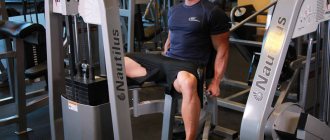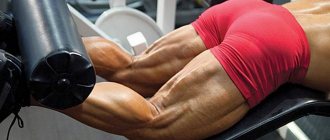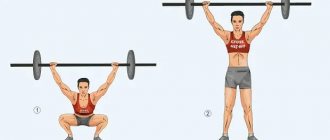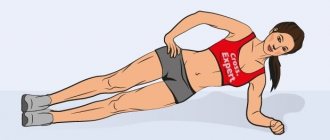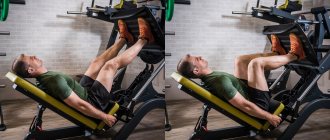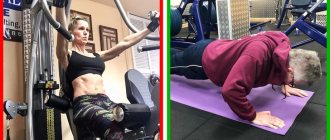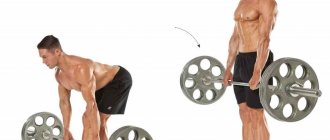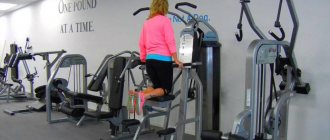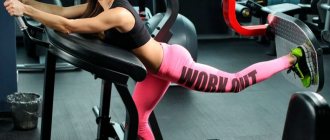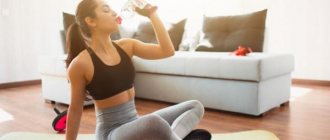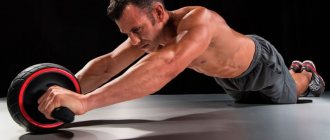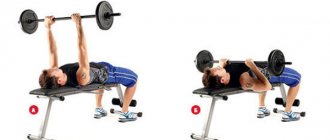The rowing machine (or Rowing Machine in English), after its appearance in gyms, is gradually gaining popularity. Now there are even entire studios that are dedicated to rowing machine training, taking advantage of all its benefits.
For reference. The rowing machine is a metal frame with a comfortable seat. The seat can move forward and backward along the guides, simulating the movements of a rower, which is produced by pulling a crossbar (handle or oar) on a cable from the front of the machine or two side levers.
With its help, you can not only exercise the aerobic and muscular systems of the body, but also successfully work with diseases of the spine: osteochondrosis, curvature, stoop. This exercise machine is part of a group of cardio equipment, which also includes a treadmill, exercise bike, elliptical trainer, and stepper. And all of them are successfully used at home.
If you want to buy a rowing machine for your home, you will need to know that they come in different types: aerodynamic, magnetic, mechanical. You also need to pay attention that load sources are different: water, magnetic, magnetic-air, electromagnetic.
The functions of rowing machines depend on all this. And with today’s development of the market and technology, they can surprise even professionals. The most popular brands of rowing machines are Torneo, Concept 2, DFC, Starfit and many others.
Also, when studying the features of this apparatus, carefully study which muscles work when exercising on a rowing machine. Since the workouts simulate rowing movements, you might be surprised to learn that these movements use about 75% of all muscles, including the muscles of the chest, back, abdomen and arms.
Therefore, the benefits of a rowing machine are many: • Reducing body weight • Training the cardiovascular system • Solving problems with the spine • Forming muscle relief and maintaining muscle tone • Indicated for training overweight people and does not add unnecessary stress to the joints of the knee and hip
Types of rowing machines
The design of rowing machines consists of handles for both hands and a flywheel. There are two types of simulators: mechanical and magnetic .
Subtypes of mechanical rowing machines: aerodynamic with a built-in fan, hydraulic. The main disadvantage of mechanical rowing machines is the lack of smoothness of movement and noise during exercise.
On the left is an aerodynamic rowing machine with a built-in fan, on the right is a hydraulic rowing machine
Magnetic trainers are much more expensive, but have a number of advantages. They operate smoothly and silently. Electromagnetic rowing machines are among the most advanced machines. A computer electromagnet built inside provides optimal load and control of exercise technique.
Magnetic rowing machine
Pros of outdoor exercise equipment
The growing popularity of a healthy lifestyle has led to the appearance of entire sports complexes in parks and city streets. Such outdoor exercise machines on sites were developed together with professionals, so you can train all muscle groups on them. Other advantages of such designs are:
- accessibility for all groups of the population;
- ease of use;
- possibility of free classes;
- hardening of the body;
- durability of devices.
Main muscles involved when rowing on a machine
Main muscles involved when rowing on a machine
Working out on a rowing machine forces different muscle groups to work. This simulator includes the entire upper half of the body - the back, arm muscles, abs, shoulder girdle and pectoral muscles. The legs and gluteal muscles are less involved. The main movement during rowing machine exercises is rowing the barbell to the waist - an exercise to strengthen the back muscles.
Simple rowing
Most people avoid the rowing machine because they don't know how to use it. It is important to understand the technique correctly, otherwise an incorrectly performed exercise can lead to injury.
A simple basic exercise consists of 3 steps:
- Start. Sit on the rowing machine, bend your knees, place your feet on the platform and secure them well with the help of bindings. Then stretch your arms forward and firmly grasp the handle. Make sure your back is straight and your abs tight.
- Jerk. Push up with your legs and straighten them completely. At the same time, pull the handle of the machine with outstretched arms.
- Finish. Once your legs are fully straightened, lean back at a 45-degree angle. Keep your arms extended. Then return to the starting position.
Rowing technique on a simulator
The technique of rowing on a simulator can be divided into 4 parts: the return phase (recovery phase), the hook or capture phase, the acceleration and movement phase, and the final stroke phase.
Before you start performing exercises, you need to make sure that the belts of the machine are securely fastened. Your heels should fit snugly against the pedals of the machine. The torso is slightly tilted forward, the back is level. When the rowing technique is performed correctly, the muscles of the back, abs of the arms and legs are worked out. By doing exercises at a fast pace, you will burn a lot of calories and increase your endurance.
1 Return phase (recovery phase)
In this phase, the body position turns into a grip. All muscles of the body should be relaxed. The arms remain almost straight. Bend your knees, then straighten your arms completely.
2 Hooking or gripping phase
During rowing in this phase, the main point is body position. If you start the exercise from the wrong position, the muscles will not receive the proper tension. Your arms should be straight and your shoulders should not be at the same level as your hips. The body position is regarded as correct if the main center of gravity is on the legs.
Important : when moving the paddle upward, it is important to remember that the load should go from the legs to the arms. By lowering your arms, as if “raking the water with an oar,” the lateral and trapezius muscles begin to work. When moving into the catch phase, you need to make sure that the movement comes from the hip. In this case, the body must be tilted no more than 30 degrees. Next, you need to tense your torso muscles and evenly distribute the load on your feet. Having fixed your shins vertically, make sure that there is no gap between the body and hips.
3 Acceleration and driving phase
After making sure that your shoulders and arms are straight, you need to firmly fix your feet. Having completed the third part of the stroke, you need to lean back a little with your body. The position of the legs remains unchanged as in the previous phase. Well-executed pushes make it possible to work at an optimal pace. Don't forget about the recovery phase! Bend your elbows and bring your arms toward your lower ribs. The work includes the lateral, brachioradialis, deltoid and biceps muscles.
Important: wrists must remain straight. Also, do not pinch or raise your shoulders.
During the acceleration and driving phases, maximum power is achieved. Starting with your legs (quads and glutes), work your lower back as well as your arms and shoulders (brachioradialis, biceps, rear deltoids, lats, trapezius, rhomboids).
4 The final phase of the stroke
At the moment when the knees are completely straight, the final phase begins. The oars should be at the level of the lower ribs, the muscles of the torso should be tense. The head, neck and shoulders should be relaxed, the elbows should be fixed behind, and the wrists should not be strained.
Some tips for beginners: don't rush into the recovery phase. This leads to the formation of microcracks in the muscles. Pay attention to the grip of the handle. Don't squeeze it too hard. The most correct option would be to softly grip the handle with your fingers. Beginners should choose and follow the correct exercise technique rather than work hard to burn the maximum number of calories. Improper rowing can lead to injuries, sprains and muscle pain. It is important to start exercising on a rowing machine and gradually increase the load and intensity.
Side rowing
This modification of the classic rowing exercise not only works the arm muscles, but also helps strengthen the oblique abdominal muscles. This modification of simple rowing increases the load on the pectoral muscles.
- Take the “Start” position. Make sure your back is straight.
- Now push up, straightening your legs.
- At the same time, pull the handles to your left side and lean back.
- Do 8 reps on the left side and then repeat on the right.
Common mistakes when performing exercises on a rowing machine
The main mistakes when performing exercises on a rowing machine are :
- Bent back in starting position
- Straight elbows (leads to elbow joint diseases)
- Straight knees (leads to knee joint diseases)
- Bent back (exception is the third phase, when you need to slightly tilt your torso)
- Incorrect rowing sequence on the machine (beginners, having not mastered the technique of performing the exercises, go straight to an intense tempo. Only after learning the movements at a low tempo can they move on to working on a rowing machine at a high tempo).
Simple rowing with gymnastics
This is no longer a variation of rowing, but a separate workout. The peculiarity is that we alternate rowing with gymnastic exercises.
- Do one rowing set (12 times) or for 1 minute.
- Then do 8 alternating lunges.
- Do the rowing approach again.
- Then do 8 squats.
- Do a final rowing set.
You can replace lunges and squats with other exercises, depending on which muscle groups you want to focus on in your workout.
The benefits and harms of rowing machines
Exercising on a rowing machine is considered cardio exercise.
Rowing exercises strengthen:
- respiratory
- cardiovascular
- nervous system
Rowing is improved:
- muscle corset
- increase the body's endurance
- speed up metabolism
In one session lasting 30-40 minutes, an athlete spends about 800 Kcal - an excellent indicator in the fight against excess weight.
Modern electromagnetic simulators are equipped with special computer programs that clearly control the entire training process. Another advantage is the fact that rowing machines at a low pace are recommended even for pregnant women.
Thanks to exercises on a rowing machine, reliable prevention of diseases of the musculoskeletal system and spine is carried out, and also increases flexibility and mobility of joints.
Studies show that regular training on a simulator increases sexual activity in women and men.
If you are considering using a rowing machine, consult your doctor first. Sometimes exercise is harmful to the body.
Rowing is contraindicated for people with the following diseases:
- Hypertension
- Thyroid diseases
- Cardiovascular diseases
- Infectious diseases (ARVI, influenza)
- Some diseases of the spine
Where to study?
You may be interested in: How to quickly lose weight in the gym for a woman: workouts for weight loss
A rowing machine is commonly found in all gyms, but you can also purchase one for use at home. If you're looking for home workout equipment but don't have much space, a rowing machine may be the perfect option. It is relatively lightweight and does not take up as much space as other fitness equipment. You can choose an option in both the high and low price segments. Often, a rowing machine is even cheaper than a treadmill or bicycle.
Contraindications
There are contraindications due to which you should choose a different simulator:
- Any complications with the back, for example, hernia, sciatica. In this case, a consultation with a doctor is required, who will either prohibit training on it or adjust the training plan.
- Cardiovascular diseases.
- Problems with blood pressure.
Exercises performed on a rowing machine are not suitable for everyone; this must be taken into account when choosing equipment. Some people may get bored with repetitive movements that need to be performed for 30-40 minutes. If you do not follow the correct technique, you can injure your back.
All sports activities should be postponed if a person has chronic diseases in the acute stage or has elevated body temperature. Before starting a workout, it is imperative to focus on your well-being. Many people believe that colds are not a reason to postpone classes. But the load on the heart muscle increases, so training will be hazardous to health.
A rowing machine is one of the most effective and multifunctional home sports equipment. By exercising it, you can lose excess weight while maintaining muscle mass. Despite the simple principle of operation, you should know which muscles work on the rowing machine and follow the exercise technique to minimize the risk of injury. There is a large selection of sports equipment models on the market, and everyone can purchase a suitable option for home use.
